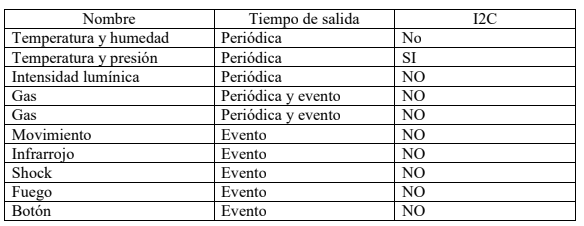Monitoring Report of the DSH Project (Sensory Device for Homes)

Introduction
Taking into account that the life expectancy of humanity has increased, especially in developed countries, the population of elderly people has increased considerably in recent years. Likewise, as a consequence, the numbers of health emergencies that occur in their homes have increased. Currently, to avoid this, it is necessary that family members, caregivers or even health centers are in constant communication with the elderly, since, the older the person, these situations can become complicated and dangerous for their lives.
The life of this project has been carried out following a planning that consists of different stages of it, the first stage focused on the study, the second in the design of the device and the third in the development of the same. The study stage was based on the realization of the state of the art, in order to know the advances that are made on the subject of home security for older people with the use of technology. When performing the state of the art in the area, we could highlight that many studies focused on topics such as improving the daily life of older people using a sensor system at home; emergency alert using wearable devices (bracelets, watches, anklets, clothing, among others); and emergency alert using simple home devices (no large installation required). Each topic will be described later with examples of work done in that area.
The Sensory Device for Homes (DSH) is a non-invasive device that is intended to be a system that aesthetically looks like a simple decorative object of the home and that internally possesses all the necessary sensors to perform the recognition of the user's daily life patterns (people who are usually close to him), in addition to this, by artificial intelligence will be able to perform a training, continuously improving the life patterns stored, said device must be placed in the room in which the user performs the most of activities or spend the most time. In principle it has been thought that the DSH assistant should be placed in the room, since many of these older people spend much of their time watching television in that place.
The main objective of DSH is to be able to generate and continually train the life pattern of the elderly person (end user), in order to alert family members or the nearest health centers when older users have suffered an emergency such as a fall , some motor or cognitive problem, among other aspects that can be detected by the change in behavior in their daily lives, so that they can assist them before the situation presented worsens.
This device is intended to be a decorative object in the homes of the elderly, especially if that person lives alone or if he spends a lot of time without supervision. Daily the device collects information about the person's behavior and about environmental measurements, and is responsible for sending all the information to a database that will be used to train a neural network that allows recognizing the behavior patterns mentioned above.
Throughout this document they will mention some work previously done in the study area. On the other hand, all the details that were considered when designing and developing the final device, including the different electronic elements used and the connections made, will be described. In addition to this, the considerations taken at the level of software development will be mentioned.
State of the art
Some of the alternatives most studied or used to provide security in the homes of the elderly are observed below.
• Improve everyday life using a home sensor system.
Some studies have had the initiative of using sensors in all rooms of the house in order to create a pattern of life for the elderly. As an example we can observe the study carried out by (Pollack et al., 2003), which proposes a system of adaptive and personalized reminders that allows us to choose intelligently whether or not to issue a specific reminder or whether to advance or delay the time of the same (depending on the activities that the user is or will be doing). However, while this may help to plan the routine of the elderly person, as mentioned above, there is no alert in case these planned activities are not carried out correctly, which could indicate the presence of A possible problem that needs attention.
Another project that aims to use multiple sensors in the home is observed in (Lago, 2018), in this study the LaPlace system is presented, which is responsible for managing the patterns of behaviors observed in the user, making a learning constant of said pattern of life. This study specifies that such adaptive learning can be used to observe changes in the person's habitual behavior, allowing to detect possible cognitive or physical health problems. However, in this work the action that the system will perform when witnessing a change in the user's habitual behavior is not specified, in addition to this, the article does not mention the types of sensors that were used for the study.
There are other studies, as detailed in (Botia, 2012), which follows the same principle as the two studies described above, in this we propose a system of sensors placed in each of the rooms of the user's house, the system It is made up of:
• Motion sensors in all rooms.
• Pressure sensors in different household furniture.
• Sensors on all doors, so that it is possible to know when they open and close.
This project is intended to alert the relatives of the elderly at the time they present a fall or other emergency observed by the abnormal behavior in the responses obtained by the sensors, on the other hand, the system learns over time , therefore, your alarm will be increasingly accurate.
The main problems that these three systems have (from our point of view), focus on two aspects, first, the system requires an exhaustive installation, since it is necessary to place different sensors throughout all the rooms of the home, sometimes having to install more than one sensor per room. This can generate insecurity or discomfort to the end user (the older person), as he will feel that he is being invaded in his own home. On the other hand, the second aspect that we could observe about this type of systems is the cost of said installation, since it is a large-scale system that must cover the whole person's home, therefore, the cost includes the hand of work of the personnel for the installation, including, in addition, the cost of the different sensors to place. DSH on the other hand is intended to be a single device that aesthetically does not stand out in comparison to any home decoration item, and the only thing that is required for installation is to be connected to the current, thus being a much more economical and less invasive device .
• Emergency alert using simple home technology systems
The study described in (Joshi and Nalbalwar, 2017), presents a system composed of a single camera that is responsible for collecting user life information, this system, like the DSH household assistant, is intended to be placed in the room of greater use by the user. The system has a process that analyzes the information obtained by the camera, which is responsible for noticing if the elderly user has suffered a fall. On the other hand, it notifies by means of an email the people indicated previously in the system, to which they are sent attached part of the recorded video and a screenshot, in addition to this, it is possible to observe a direct transmission of The home room. In comparison to the studies described above, this system performs the entire desired process for a low installation cost, however, it is not able to observe other types of emergencies that could occur outside the visualized area, since the system does not consider the time when the user is not in his field of vision, on the other hand, when using a video camera, this system will not have the desired acceptance, taking into account that many of the users think that the camera is a very invasive device.
Another study that is designed to help elderly people at a low cost is proposed by (Principi, 2015), in this there is a device with audio sensors that is connected through a local network to all possible devices. The system allows the user through voice commands to trigger automatic telephone calls as a distress alert to a family member or health center previously indicated in the settings, so that they provide the necessary assistance. All these aspects will be considered by the DSH device, but in addition to these, the device proposed in our project includes other sensors with the purpose of not only working through voice commands, but also to perceive changes in the person's daily behavior, for if it is unable to pronounce the voice command, it is possible to identify the emergency by other aspects.
• Analysis of user behavior with wearable devices.
One of these works is described in (Pierleoni, 2014), in which a device is designed to be used on the ankle of the user, this is capable of sending alert messages to previously configured phones in the system, these alerts are sent when the device detects that the elderly person has suffered an alleged fall, on the other hand, if the person does not get up for a period of time, a second critical fall alert message is sent.
Another study that focuses on the use of wearable devices is detailed in (Chernbumroong, 2013), this designs a system that consists of three sensors, an accelerometer, a temperature sensor and an altimeter. The study suggests that with these three sensors it is possible to generate the correct classification of most of the activities that are carried out by the elderly. This system is inserted in a common sports watch, so that users do not feel different from using this device to a normal accessory to see the time. The data obtained are processed to create patterns of behavior, being able to classify the movements made by the user in 9 different activities of the person's daily life. However, this study only develops the information of the activity recognizer, not indicating the possibility of detecting falls or other emergencies with the designed device.
It is necessary to point out that these two studies mentioned above are based on designing wearable devices, which require that, for its proper functioning, the older person is placed (use) the device on a daily basis, it is necessary to remember that older people can forget performing this action, in addition, many times they do not want to feel identified as being dependent on said device when using it on the street, without taking into account that these may bother them because they are not accustomed to wearing said accessories.
At present there are devices and home systems for sale for this purpose, however, like the studies described above, these products have not been widely accepted, because they are mostly considered invasive (for all the above mentioned), or on the other hand, they are forgotten or unused because it is a wearable device, since it is possible that the elderly person is uncomfortable to use them or simply forget to place them daily, on the other hand, there is a device that even the user needs to press a button to send the distress message, which presents major inconveniences, since it is possible that the same user is immobile when falling or having another type of health problem.
Hardware
The prototype developed is a non-invasive device from the point of view of everyday life, since it does not make video recordings of the area in which it is located and, therefore, neither of the people around it. Said device consists of a set of sensors (nine to be exact), which allows to measure the different signals obtained from the environment, on the other hand, this device was developed in a raspberry pi, to obtain as a result the creation of a portable device and powerful.
Software
Regarding the software, it was already mentioned that the operating system used is the Debian-based GNU / Linux, called Raspbian, since a Raspberry has been used as the base device. On the other hand, the coding of each of the sensors used has been done in the Python programming language. It was necessary to download libraries to properly use some sensors, while in other cases it was necessary to completely program the operation of the sensor based on its datasheet (information sheet).
Another important aspect to note is that the sensors can work in two ways, this will depend on the time between an output and another of the same sensor. In this device you can see sensors that work for events, these events activate the sensors, and these in turn, activate their output pin; on the other hand, there are the sensors that periodically obtain information from the surrounding environment. Table 3 shows this classification in the sensor output.
On the other hand, there are sensors that require the use of the i2c interface, which is a useful bus that allows data exchange between microcontrollers and peripherals with a minimum of wiring. Data transfers are carried out via the SDA data serial line, while the SCL line carries the clock signal that synchronizes the data of the SDA line.

Table 3. Sensor Output Management
The sensors that periodically collect information do so at a configurable time in the source code of the device developed, for the moment, information is collected every 5 minutes, sending this information to a database, which includes the time at which the signal was perceived. On the other hand, the sensors that collect information depending on an event, such as, for example, the motion sensor, which is activated when it detects a movement in its field of vision; it also sends this information to the database to store these events together at the time in which it occurred.
On the other hand, and not less important, a button was installed that allows the on and off of the Raspberry, this button turns on the device to connect ground (GND) to port 5 of the Raspberry (SCL) (GPIO3), while making the shutdown through pin 13 (GPIO27).
All this information from the sensors will be used to train a system of neurons in order to generate a pattern of everyday life, and be able to detect problems when the sensors collect information that is outside of that everyday behavior. In principle, these alerts will be notified to the caregiver or relative of the elderly person, in the same way, you can inform the health organizations that are near the home of this user.
The project at current time
Currently this project has completed the design and development stage of the first prototype. On the other hand, the advances of this project have been presented at the Researchers' Meeting "Research and ageing: Answers to give quality to life", promoted by the International Centre on Ageing (CENIE, 2019). Figures 17 and 18 show this presentation.
.png)
Fig. 17 Researchers meeting.
.png)
Fig. 18 Presentation of the project at the researchers meeting
On the other hand, in figure 19 the first prototype of the project can be observed, in this one there are some sensors, such as movement, temperature and humidity, infrared to identify the use of remote control, the fire sensor and the intensity of light. For this first prototype a climate application was implemented, which is observed in said figure, however, the final objective of the device is that of a digital closeup, where users can place their family and personal photos.
.png)
Fig. 19 First prototype of the project
In figure 20 we have a side view of the device, in this we can see the gas sensors and the temperature and pressure sensor.
.png)
Fig. 20 Prototype side view
References
Botia J., Villa A. y Palma J. (Julio, 2012). Ambient Assisted Living system for in-home monitoring of healthy independent elders. Expert Systems with Applications,39(9), pp. 8136-8148.
CENIE (Junio, 2019). Investigación y envejecimiento: Respuestas para dar calidad a la vida. Recuperado de https://cenie.eu/es/actividades/el-encuentro-de-investigadores-del- cenie-abre-las-puertas-nuevas-soluciones-para-dar.
Chernbumroong S., Cang S., Atkins A. y Yu H. (Abril, 2013). Elderly activities recognition and classification for applications in assisted living. Expert Systems with Applications, 40(5), pp.1662-1674.
Lago P., Roncancio C. y Jiménez-Guarín C. (Septiembre, 2018). Learning and managing context enriched behavior patterns in smart homes. Future Generation Computer Systems, 91, pp.191-205.
Joshi N. y Nalbalwar S. (Mayo, 2017). A fall detection and alert system for an elderly using computer vision and Internet of Things. En 2017 2nd IEEE International Conference on Recent Trends in Electronics, Information & Communication Technology (RTEICT) (pp. 1276-1281). Bangalore, India
Pierleoni P., Belli A., Palma L., Pernini L. y Valenti S. (Octubre, 2014). A Versatile Ankle-Mounted Fall Detection Device Based on Attitude Heading Systems. 2014 IEEE Biomedical Circuits and Systems Conference (BioCAS) Proceedings. Lausanne, Switzerland
Pollack M., Brown L., Colbry D., McCarthy C., Orosz C., Peintner B., Ramakrishnan S. y Tsamardinos I. (Septiembre, 2003). Autominder: an intelligent cognitive orthotic system for people with memory impairment. Robotics and Autonomous Systems, 44(3-4), pp. 273-282.
Principi E., Squartini S., Bonfigli R., Ferrori G y Piazza F. (Agosto, 2015). An integrated system for voice command recognition and emergency detection based on audio signals. Expert Systems with Applications, 42(13), pp. 5668-5683.








